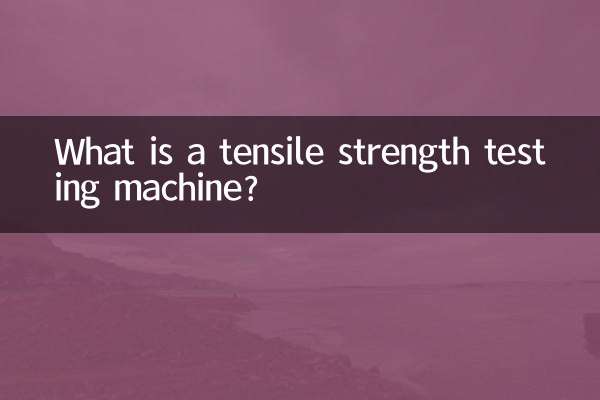What is a high and low temperature tensile testing machine?
In the fields of industrial manufacturing, material science and product quality testing, high and low temperature tensile testing machines are indispensable equipment. It can simulate the mechanical properties of materials under different temperature environments and provide key data for scientific research and production. This article will introduce in detail the definition, working principle, application fields and popular models of high and low temperature tensile testing machines.
1. Definition of high and low temperature tensile testing machine

High and low temperature tensile testing machine is a device used to test the tensile properties of materials in high or low temperature environments. It evaluates key parameters such as tensile strength, yield strength, and elongation of materials by applying tensile force and measuring the material's deformation and fracture behavior.
2. Working principle
The working principle of the high and low temperature tensile testing machine mainly includes the following steps:
1.temperature control: Control the test environment within the set temperature range through the heating or cooling system.
2.Apply tension: Apply tensile force to the specimen through a motor or hydraulic system.
3.Data collection: Record the deformation and force value changes of the sample in real time through the sensor.
4.data analysis: The software system processes the collected data and generates a mechanical performance report.
3. Application fields
High and low temperature tensile testing machines are widely used in the following fields:
1.Aerospace: Tests the performance of metals and composite materials under extreme temperatures.
2.automobile manufacturing: Evaluate the durability of rubber, plastic and other materials in high or low temperature environments.
3.building materials: Study the crack resistance of concrete, steel, etc. in low temperature environments.
4.electronic components: Test the reliability of circuit boards, connectors, etc. in high temperature environments.
4. Popular models and parameters in the market
The following are the popular high and low temperature tensile testing machine models and their main parameters on the market recently:
| Model | temperature range | Maximum pulling force | Accuracy | Application areas |
|---|---|---|---|---|
| HT-1000 | -70°C ~ 300°C | 1000N | ±0.5% | metal material |
| LT-500 | -196°C ~ 150°C | 500N | ±0.2% | composite materials |
| GT-2000 | -40°C ~ 400°C | 2000N | ±0.3% | Plastic, rubber |
5. Purchase suggestions
When selecting a high and low temperature tensile testing machine, the following factors need to be considered:
1.temperature range:Select the appropriate temperature range according to test requirements.
2.Pulling force range: Ensure that the maximum pulling force of the equipment can meet the test requirements.
3.Accuracy: High-precision equipment can provide more reliable data.
4.After-sales service: Choose a brand with complete after-sales service to ensure long-term stable operation of the equipment.
6. Future development trends
With the rapid development of materials science, the demand for high and low temperature tensile testing machines will continue to grow. In the future, equipment will be more intelligent, with higher automation and data analysis capabilities. At the same time, environmental protection and energy saving will also become important considerations in design.
In short, the high and low temperature tensile testing machine is an important tool in modern industry and research, with a wide range of applications and continuous technological advancement. Choosing the right equipment will bring great convenience and benefits to your scientific research and production.

check the details

check the details